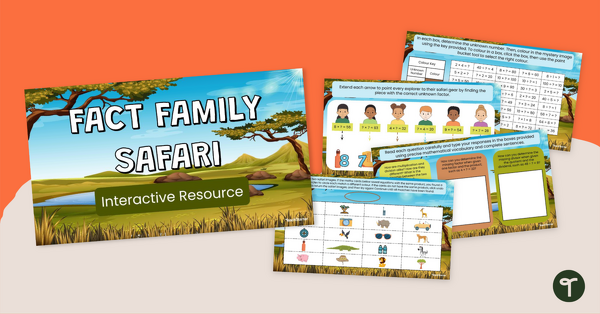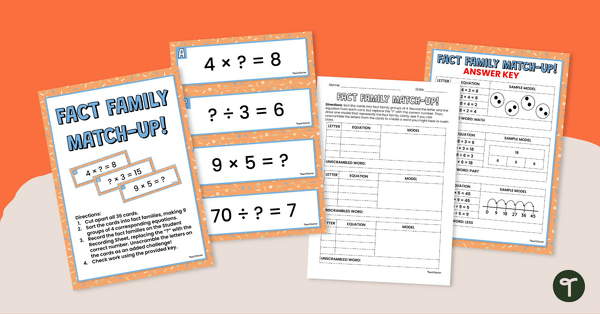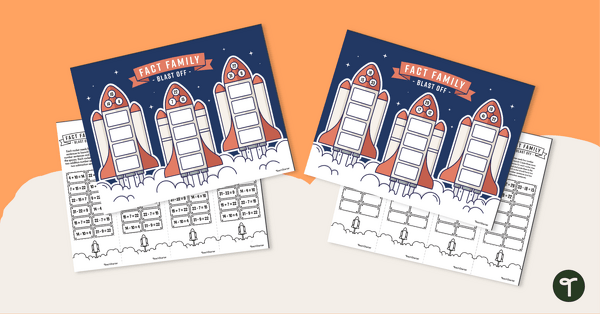Fact Family Teaching Resources
Explore fact families with printable fact family worksheets, digital activities, math games and more — all created by teachers, for teachers (and your lesson plans)!
This collection of curriculum-aligned and differentiated resources was designed to help students better understand the relationships between numbers and to develop their mental math skills.
Looking to learn more about fact families, or on the hunt for new ways to engage your students? Read on for a primer from our teacher team, including a definition you can use to introduce the concept to your classes.
What Are Fact Families? A Kid-Friendly Definition
Let's start at the beginning with a definition that you can use to explain the meaning of "fact families" to kids.
Basically, a fact family is a group of three different numbers that are related to each other (the way members of a family are) and can be used to create four different number sentences.
The goal is to use these related numbers — or families — to help kids make the connections between subtraction and addition (although it can be used for multiplication and division in the upper grades too). Knowing one fact in a family can help students solve other math facts.
So, for example …
Addition and Subtraction Fact Family Examples
Some fact families can create two addition number sentences and two subtraction number sentences.
For example, the numbers 3, 4 and 7 form a fact family and can be represented by the following number sentences:
- 3 + 4 = 7
- 4 + 3 = 7
- 7 - 3 = 4
- 7 - 4 = 3
Subtraction is the opposite of addition, so the familial relationship here is an inverse one.

What Is a Fact Family Triangle?
A fact family triangle is a simple visual representation of a fact family that can help your students understand the inverse relationship between addition and subtraction.
Each triangle consists of three numbers written at the corners of a triangle, with the largest number at the top and the two smaller numbers at the bottom corners. The two smaller numbers are always the two addends in a simple addition equation, and the largest number is the sum of those two addends.
Fact family triangles are a helpful tool for teaching the commutative property of addition, which states that the order of the addends does not affect the sum.

What Are Number Bonds?
Another concept that ties into fact family triangles is the number bond.
This visual representation of the relationship between numbers is made up of two parts that combine to make a whole. It is a way of showing the different ways that numbers can be broken down into smaller parts.
For example, the number 6 can be broken down into a number bond of 2 and 4, or 3 and 3. These bonds can be represented visually as circles or other shapes, with the whole number in the center and the parts branching off from it. You can set it up in a triangular shape too, similar to the fact family triangle.
What Is Part-Part-Whole?
We can't talk about fact families without discussing part-part-whole as these two concepts are often taught in concert with one another.
Part-part-whole refers to a problem-solving strategy that involves breaking down a number or quantity into smaller parts or components and then combining them to determine the whole.
The concept can be used in early math education to help kids understand basic addition and subtraction, as well as other math operations, and ties in nicely with fact families.
After all, by understanding the relationship between the parts and the whole in a fact family, students can use the part-part-whole strategy to solve related problems. For example, if a student knows that 3 + 4 = 7, they can also determine that 7 - 4 = 3, by recognizing that 4 and 3 are the parts that make up the whole of 7.
How Do Fact Families Help Students Learn Multiplication and Division?
Fact families can be used in all of the four major math operations, and that includes exploring the multiplication and division equations that use the same group of numbers. A fact family typically consists of three numbers — two factors and their product, or a dividend and its divisor — which are related to each other through multiplication and division.
For example, the fact family for the numbers 3, 4 and 12 would be:
- 3 x 4 = 12
- 4 x 3 = 12
- 12 ÷ 3 = 4
- 12 ÷ 4 = 3
In this "family," the multiplication equations are related to the division equations, and all four equations involve the same three numbers: 3, 4 and 12.
Looking at equations this way helps students better visualize the relationship that exists between multiplication and division, but that's not the only benefit.
By setting math problems up in the form of fact families, we help students develop the fluency they will need to move on to more complex equations. Instead of memorizing individual facts in the form of a times table, they can see patterns and relationships between numbers that help them remember the facts more easily.
This use of fact families can help students solve more complex multiplication and division problems by using what they already know about the relationships between numbers. For example, if they know that 6 x 8 = 48, they can use that knowledge to figure out that 48 ÷ 6 = 8 and 48 ÷ 8 = 6.
Hands-On Fact Family Activities
Alright, now that we’ve got that out of the way, feel free to explore this fact family collection for ideas for your classroom, and don't forget to try these ideas from our teacher team!
Colored Counters Activity
Teaching fact families is like teaching any other math concept — you want to start with something concrete before you move on to the more abstract concepts.
Get out the colored counters, provide each student with 7 counters, and tell them to place the counters in two groups.
Call on students to ask what their groups were, and write the equation on your whiteboard for students to see first as an addition problem.
For example, if a student has groups of 4 and 3, you would write 4+3=7.
Ask that student to flip their counters, so the groups are opposite, and write the representative equation: 3+4=7.
Now ask the student to take away one group — 7-4=3.
And so on.
Pop It Fact Families
Push bubble fidget toys are a hot commodity in schools these days, so use them for math centers!
Hide facts (with answers) throughout the Pop It by writing numbers on the bubbles. If the numbers are adjacent and make a completed fact — for example, 7-4=3 — the students can push the numbers down!
Create a Fact Family House
Following the family theme, building a fact family house is not just a good way to cement the concept but also a pretty fun one for kids.
They can draw their own houses — model one on the whiteboard showing a triangle roof and a square house with four squares for “windows” inside.
In the attic (the triangle), have your students write the 3 numbers of the fact family.
In each window, they can then write the 4 number sentences that can be made with those three numbers.
- Plus Plan

Fact Family Safari (Multiplication and Division) Interactive Resource
Go on a colorful safari adventure with your students and help them solve interactive challenges whilst learning about multiplication and division fact families!
- Plus Plan

Fact Family Matching Game (Multiplication and Division)
Use this engaging and fun game to practice fact families and the relationship between multiplication and division.
- Plus Plan

Fact Family Icosahedron (2, 5, 10 Multiplication and Division Facts)
A hands-on game to play when learning about multiplication and division fact families.
- Plus Plan

Fact Family Houses Worksheet Pack
Use these fact family houses worksheet set to practice addition and subtraction fact families with your students.
- Plus Plan

Fact Family Math Blast Off - Addition and Subtraction
Demonstrate an understanding of addition and subtraction fact families with a fun cut and sort activity.
- Plus Plan

Multiplication and Division Fact Families Teaching Presentation
Introduce your students to multiplication and division fact families with this 18-page editable instructional slide deck.
- Free Plan

Fact Family Find and Flip - Addition and Subtraction Up to 20
Addition and subtraction game cards demonstrating the relationship between fact families.
- Plus Plan

Fact Families (+-) Interactive Activity
Use this fact family houses resource to teach and practice addition and subtraction fact families with your students.
- Plus Plan

Cut & Paste Fact Family Worksheets
Use these fact family houses worksheet set to practice addition and subtraction fact families with your students.
- Plus Plan

Fact Family Mazes Differentiated Worksheet Set
Use this differentiated worksheet set to provide independent practice of fact family knowledge to solve multiplication expressions.
- Plus Plan

Moving Mathematics Activity - Fact Family Triangles
A fun mathematics activity that explores the inverse relationship between addition and subtraction.
- Plus Plan

Addition and Subtraction Fact Families Teaching Presentation
Use this 19-slide editable slide deck when introducing addition and subtraction fact families to your students.
- Plus Plan

Multiplication and Division Fact Families – Memory Game
Challenge students to recall and remember fact families with this multiplication and division game.
- Plus Plan

Fact Family Icosahedron (4, 7, 12 Multiplication and Division Facts)
A hands-on game to play when learning about multiplication and division fact families.
- Plus Plan

Fact Family Icosahedron (3, 6, 9 Multiplication and Division Facts)
A hands-on game to play when learning about multiplication and division fact families.
- Plus Plan

Fact Family Fishbowls - Multiplication and Division
Demonstrate an understanding of multiplication and division fact families with this sorting activity.
- Plus Plan

Fact Family Find and Flip - Double-Digit Addition and Subtraction
Practice working with addition and subtraction fact families using double-digits with this math game.
- Plus Plan

Fact Family Find and Flip - One- and Two-Digit Addition and Subtraction
Addition and subtraction game cards demonstrating the relationship between fact families.